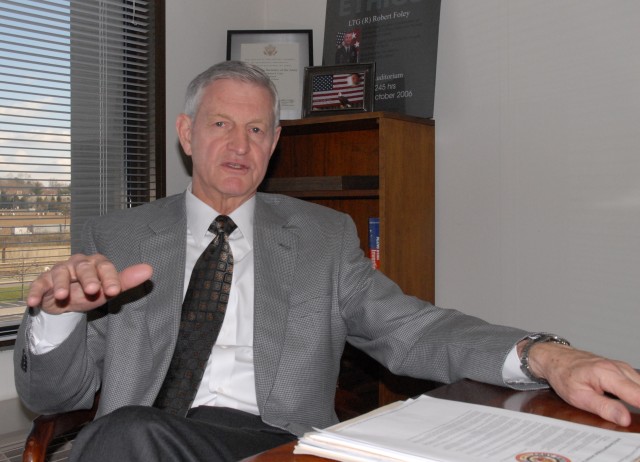WASHINGTON (Army News Service, March 21, 2008) - The Army Emergency Relief program has increased the financial assistance it provides to Soldiers and Families in need by about 40 percent since 2005, according to the program's director.
Retired Lt. Gen. Robert F. Foley said AER provided about $44 million in emergency interest-free loans and grants, as well as need and merit-based academic scholarships in 2005, and by 2007 that number increased to almost $74 million. The 2008 fundraising campaign is well underway and scheduled to last until May 1.
<b>Soldiers Helping Soldiers</b>
AER lets Soldiers help Soldiers, and it is primarily funded by Soldiers through donations or repayment of AER loans. The 2007 campaign raised $10.9 million. According to Foley, about 85 percent of AER assistance goes to staff sergeants and below.
"There are privates who really appreciate what AER does and are highly motivated to take out a monthly allotment of $100, which for a private is a lot of money; but I've seen it," he said. "But my major focus as we go through our campaign is not to twist anyone's arm to give money. I don't even mention that I encourage you to give to the campaign. My focus is on ensuring they understand what AER does for them and let them make their own decision. It's not how much."
<b>Command Referral Program</b>
Foley attributes the rising success in helping active-duty, reserve-component and retired Soldiers, Families and survivors to increased education and awareness among Army leaders - he and his staff frequently brief leadership courses and schools - and the Command Referral Program, launched in 2006.
Under the program, company/battery commanders and first sergeants can authorize $1,000 in interest-free loans to their Soldiers for car repairs, emergency travel, rent or really anything the Soldier needs.
"It allows the chain of command to be involved in their moral obligation to take care of their Soldiers," said Foley, adding that last year 30 percent of all AER assistance Army-wide was attributed to this program and that the number is much higher at some installations.
"As commanders, I think it's important that we recognize those Soldiers who need help and let them know it's okay to come forward and ask for the help the Army can provide them. I never see a unit come together more than when a Soldier or a Soldier's Family needs help," said Capt. Eric N. Durrant, a battery commander with the 3rd Battalion, 27th Field Artillery Regiment at Fort Bragg, N.C.
<b>Exception to Policy</b>
According to Foley, each Soldier's case is different so there are no strict rules about what AER will or will not cover, and there are no limits on the amount of the loan or grants Soldiers can receive or the number of times they can apply to AER. AER, he said, simply wants to help Soldiers in need so they won't have to go to payday lenders and pay exorbitant interest rates and get into debt. They should always ask for assistance.
"Soldiers sometimes will say, Army Emergency Relief takes care of rent and utilities and emergency travel and medical issues, but they don't take care of this specific issue that I have," he said. "I'll use an example, some children have a misshapen head, I don't know the exact term, but they need a cranial helmet to help shape their head. TRICARE doesn't pay for it - they're about $3,000 - but we do. And in most cases, we make it a grant.
"We have a policy which I call 'exception to policy' and every garrison commander has the authority to make an exception up to $3,500. And what's great about it is that we're empowering them. They're the ones who have the authority to say, if it's the right thing for the Soldier and the right thing for the United States Army, I have the authority to make this exception. And of course, all the staff up here make exceptions.
"I think it's important that we have the flexibility to make those decisions, because in these difficult times, when Soldiers are going on multiple deployments, you never know when a Soldier is going to make a lifetime commitment to the Army, saying 'You know, the Army's helping me in a lot of different ways and I got through this because Army Emergency Relief stepped up,'" said Foley, who added that if the assistance starts as a loan and the Soldier finds he or she can't afford the payments, AER will often convert the balance to a grant.
"My son got real sick," said Spc. Eddie L. Sherrod, a fire-detection specialist with the headquarters battery, 3rd Bn., 27th FA Regt. "You're already dealing with going to war and...your only son has cancer. That's a blow in itself. AER actually paid all my medical bills and they didn't give me a loan...they gave me a grant. I think that helped us a whole lot, mentally, because I was really drained."
<b>Grants for Wounded Warriors</b>
AER also has other, specific programs. According to Foley, every Soldier who has been medically evacuated from theater is entitled to a $200 grant from AER, and he is very concerned that all wounded warriors receive these grants, as well as information on AER assistance, as spouses may quit their jobs to help care for them. He said AER is in the early stages of partnering with the 35 Warrior Transition Units and Soldier Family Assistance Centers around the Army.
<b>Scholarships</b>
Spouses and children of active-duty and retired Soldiers are also eligible for need-based scholarships of up to $2,900 a year - family income must be below $88,500 - academic scholarships of $1,300 and achievement and leadership scholarships of $1,000. Some students would be eligible for all three, and all are for the undergraduate level.
AER offices are located at the Army Community Service building on Army installations, and can also be found through the Navy and Marine Corps Relief Society, Air Force Aid Society and Cost Guard Mutual Assistance at other military installations, and Red Cross chapters nationwide. To find an AER office or for more information, visit <a href="http://www.aerhq.org"target=_blank>www.aerhq.org</a>.




Social Sharing